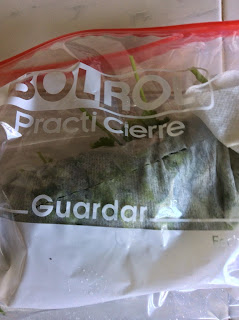| Cabbages may be Kings in the Pátzcuaro Mercado. But even a King needs to be purified. |
Mexico's mercados are a joy to the dedicated home cook and foodie. But there's a dirty underbelly to the abundance of inexpensive fruits and vegetables offered there. If you, as we are, are interested in maintaining your health while enjoying the bounty of fresh produce, there are a few simple steps you can take to do so.
Some of these tips were picked up several years ago on Victoria Challancin's blog, Flavors of the Sun, but I don't have the exact quote.
The essence is that when you get home with your mercado swag, you do not put them away until you sort them, trim them and clean them.
Here, at Las Cocinas del Rancho Las Cuevas, we first open all the bags and lay out the produce on our ample kitchen counter. The different vegetables are roughly sorted according to type and dirtiness.
| La Cocina in pristine condition before we moved in. |
Then we go to the cupboard for a few simple tools.
1. A bowl big enough to hold a medium sized cabbage or a "tree" of celery for washing.
2. A tall plastic container used for the disinfectiing solution.
3. A colander, sometimes two, if we have a lot of produce to purify. With two, you can set up an efficient line of purification , but for small amounts of produce, one will do.
4. Clean kitchen towels or aprons; or plastic bags.
 |
| Simple tools of purification |
1. Spoiled or discolored areas, such as outer leaves are trimmed away with scissors or a sharp knife. Pick out any yellowed or ugly parsley or cilantro branches. Then taking the cleanest items first, they are washed under cold water in the bowl, scrubbing with a brush if necessary. Rinse in cold water.
2. The tall plastic container (or another bowl, what have you) is filled with cold water, then Microdyn disinfecting drops are added. I usually put 4 drops per liter of water, then add a few more for good measure.
 |
| The Microdyn bath |
 |
| Pepinos Persas prepare for purification |
 |
| Pepinos get washed in cold water |
 |
| Cilantro tends to be schmutzig, sucio, dirty |
 |
| Trimming roots, clay, y ¿quien sabe? from cilantro before washing and disinfecting |
 |
| Pepinos Persas drain while new vegetables are washed and disinfected. |
A. clean kitchen towels or aprons
OR
B. Clean plastic bags.
(And, NO! Don't reuse the plastic bags from the mercado to re-bag the produce, for if you do, you will have just undone all your careful work!)
 |
| Cilantro, now clean and pure, about to be wrapped and refrigerated. |
 |
| Cilantro, in a paper towel then bagged in a Bol Lock bag. |
Then refrigerate.
Doña Cuevas is a fan of the kitchen towel/apron wrap method, for increased longevity of the greens. I, prefer clear clean plastic bags for their visibility of what's inside them. Searching for apron and towel wrapped Anonymous Produce tends to make me crazy.Your kitchen needs will vary.
A side note: if you keep your produce drawers clean and well organized, your fresh produce will keep longer as well as be easier to locate when you need it.
There are a few exceptions to this ritual of cleaning and disinfecting. Optional items like tomatoes, avocados, green beans, or chard or spinach, and especially nopales we don't wash and disinfect until just before use. And obviously, if it is to be cooked, it's only washed well, but not disinfected, just before cooking. I don't disinfect nopales ahead, as I found that they become slimy before their time.
Besides disinfecting your produce purchases, pay attention to the work surface and knife and cutting tablet to keep them clean and sanitized. We wash the kitchen tools with dish detergent and water. Our wooden block butcher's and baker's table is similarly washed, but with very little detergent, then gone over with a solution of white vinegar and water, then dried. The same methods can be used to clean the counters.
With these simple but effective Rites of Purification, you greatly lessen your chances of food borne illness.